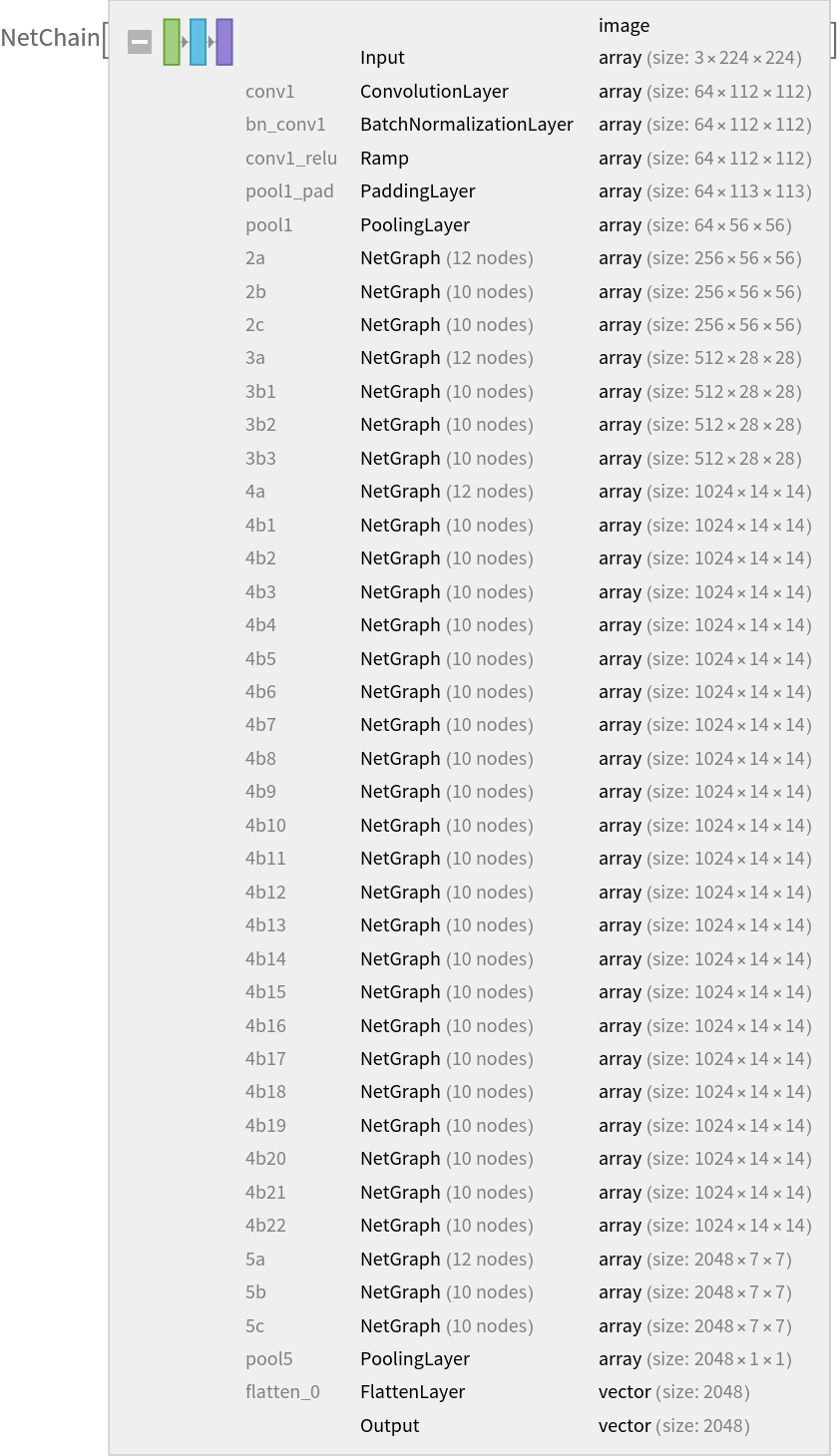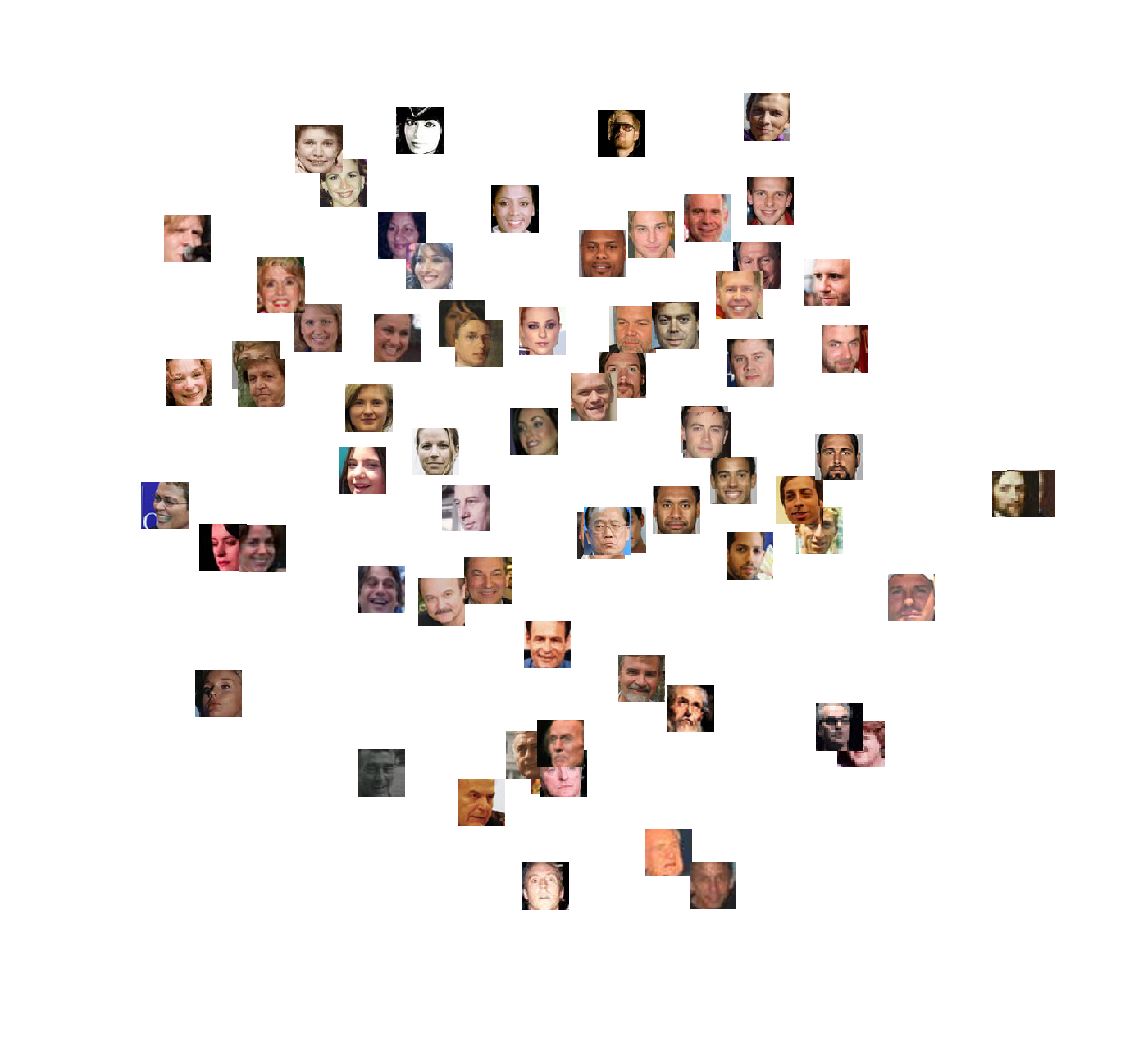ResNet-101
Trained on
Augmented CASIA-WebFace Data
Released in 2016 and based on the ResNet-101 architecture, this facial feature extractor was trained using specific data augmentation techniques tailored for this task. Starting from the CASIA-WebFace dataset, a far greater per-subject appearance was achieved by synthesizing pose, shape and expression variations from each single image.
Number of layers: 345 |
Parameter count: 42,605,504 |
Trained size: 172 MB |
Examples
Resource retrieval
Get the pre-trained network:
Basic usage
Compute a feature vector for a given image:
Get the length of the feature vector:
Use a batch of face images:
Compute the feature vectors for the batch of images, and obtain the dimensions of the features:
Reduce the feature vectors to two dimensions with t-SNE:
Visualize the results:
Obtain the five closest faces to a given one:
Net information
Inspect the number of parameters of all arrays in the net:
Obtain the total number of parameters:
Obtain the layer type counts:
Display the summary graphic:
Export to MXNet
Export the net into a format that can be opened in MXNet:
Export also creates a net.params file containing parameters:
Get the size of the parameter file:
The size is similar to the byte count of the resource object:
Requirements
Wolfram Language
11.2
(September 2017)
or above
Resource History
Reference

![features = NetModel["ResNet-101 Trained on Augmented CASIA-WebFace Data"][\!\(\*
GraphicsBox[
TagBox[RasterBox[CompressedData["
1:eJylmQVUm/nW7ntOi7u7U9zdIbg7FEmQhCS4u7u7u7u7S5W6C4UCLVBKqXs7
7Zzh7pQ5nZ6Z+c5377qs3ayXl5SVX569n2f/Ax86yBb3zyNHjoSRwoOtZxQi
NNQzxo4WvnEIDPPBB2K9TALDsXhsqAr6KNw0+/0f4frFq28vPh3go1Ol9Uxp
BUSJGJjJGZkpGJiIaGip2ThImFip2XgoWbjoOHlJaJmoWNgoGVmomVlJaOjI
6RkpGZmhKJiYSeloiaipyGlpiSkpSampKejo4JqIguIYOTkpJRUZFTUJBSUp
JQUJBTkJGen3IiYmJSIiOXaU6J/EpEehqKjJ6KjIGajJ2egpuRkphDgZhDjp
+dlo2RipaajJScnJ/klMdJSI8HwiEvi/JEf+cQQe4VfBryWjoSKiIAtLirux
trq6ubW6vrW5+WTj0e761uMHj3YA8N3Xg+TCGmp+URpeYVpuPgomFjIGRhI6
ehp2zkNAGnZeeg5+UjpmGjYOGhZ2AIR3AAouKJlZAJCYlo6YhsD1MyDQHSUj
A0ByahoAJKemghcDL/V7kUAB4zHio+RUxBRUpPR0lIx0lEDHz0ojxceqISWg
IsYlK8wlzMvKysJARUMJLIB2jBj+CxHQwS/5x1EC7DFSEmA/Rk7qiEHeeLAC
UCtrD9fXHz/Y3Fl7uH3vweaL119efzkobeomYuNnEpKkYeemYuWkYuclYeQk
Z+IgoWakYuen5xKgY+MkoqGj4uAmY2EnZ2IhZ2SgYGalZmWnZmUDRiIqmqPw
TtITAOFpoC8ZNd0xUjJicsLbS0xJTkxDSURGTgFfJMdoqMmoachAPniRZKRU
lPS05JRkdNRk7HSkMrwMKseZTeR47dWFDWU4jGX5VIVYBThoGVkoiWlJ/kly
lISEiIj4H8TEx4iIiI4dIzwSf/86evQfYgriy9cvrT3avL/xaGP7ycr69sr6
o5WH2wD48deDwbmzlLyi9AJitBygFzctlwAFKzcAktIyULDy0rHzUDGxEtPS
U7NxUbJzURCEYyJjZIaOBUAqFlZialoAhEYFQLg+BAQiEA7UJKGiIqElgIAK
FBRkTMx0lNRk/zx6hIKcmJmOmoHyGCcDuawAu66UgJmCkIu2FNpQ1lNXEoUQ
P6EmYirDJyfIwslOTcNIRUFFTkJEfJToCOh+7HvHwiM0KhTcoedkbOnt2H76
9O7axp3VDQB88OgxAL5+/cunrwcXbq0zishScQoAAjDScfKDiNCTxNR05Cw8
NKxcQEpCB6qx03DyAyAVEwspdCkTCyVBRzZSWnoAJKGlARZghEdoVAIgFRUA
wjV0LCUTLQklKT09LQMjDRnpUXpqIhEOBgU+doQwq7OWJEpHCqsv62esEGiq
gEWIBpjIBpnJ4vUkUVpiRrICItyMzMzUNDBrIDzxP+DhsFcP5xEK7lCx0qbl
Z91YvX9ndR20W92E/nwIF2/efH3z4eD6yjaXtCopCzclCwfgwNxBEVEzEFHR
UrLxwR24IGMA1VhBXLLvLgSN+n1amaBFyegYjlFSwxgCC8FJKCjBWMBkyOA1
MTBQgF/R09GAXdBScLAwcjDQctJRyAswm0jzOqsIR1oqZLjqJtqrx9uqJjmq
RVvJB5tIpLpqRVpIh5hK+pvKIhFSGhJcvGx01NSU0PbHyI4eIyOC0TtKQvxH
kR6jYacvb6pZ3d4Cn7lxd/X+xtbt++u37z8AwFfv/gWAx5URZKw8h4BUrNxg
LAAICsIF3DlGSUPBwExCz0wApCcQUbGyQ4uCrMAIjgpjCIAgGRkFwTlBMlIq
WpCPlpGJjoGeiYWZnYWWi5FGlJ1JgYfdRErAWU0EqyGUYKFU6W1Y5KZZjtMv
9dLNQapnuKjkeyGy0VpxdjKxdnKhVrI4MxlbTTEpQXZaOgoSKgoi8mNE5ARv
OaxDQEAmZiCPzUi6cvcOGAsAgnY3762BmtCi7z8fXL77UFBJl4KNHwCpmDlg
+oCRmIYRRokQE0zsRymovgOyQvdSMLIRMoKFA0wGBpPASAdvBS0wEsYNUgA8
k4Ye7gAmaAdtyc7GJMTBpMjPqSPAYSHO46svm2SnluWoUo3Rawo0rPPVbfQ3
KsNoFnlqFmG0yn31M1Cqma4qSc6KoZYSPkbibroS2pI8rEyUJNQk32Pl99H7
3pyELgVPPkJ+VNfSdGJp8frK6t21TejP63dWVtYfHprMwqXbnFJqlOwCwELO
wErKwAaMAAgqACAkIzEFNQDCfVoOPsJz6JlIGVioWTiBDmwTZhDoCICUNATz
hLCgJQBCi9LQ0TLRUfOwM8sf5zRXEEOqiPlrS6Q7qNd4G7UGm7UHmwBdW6hp
rQ+i2E211luvzs+gxEuzGK1V4KmVhVSNsZMONBLBaAtbKQiI8TLT0EKGHvt7
QIpj1kin5RvXb66uX7u9cmvlwc17q9CiAPjhXwf9M6eZRRS+A3IeApIxEtQB
QGhRgnbfWxTuHwpKRsd4lJoetCalZySISEMPM3gICNFAaE4GJmAEBenoaNgY
aYW4WHWkjzuqywQZK+cjDep9TZqDjLqiLdtCjdpCzKGa/AzbgkwPq9JLuwKj
VeqlV4TRyXFTj7GU8tUUclUT1Zbm52ClISMnIiUlJv3+BQFxmBRwScZKhw8L
Wji/fOM+oK0B4LXb9wDw9dvfIOi7x0/SC8lScAqAK0KUE3SBAaRhBKVgjSGg
gcnQMYJqxHQsDJx8IChMIrwVx76HAhQROSHQgY6cnJyKiooG3hxaBsJ7RUYh
wMRoJC5soSSC1pPNdjOuwJn2RJ4YjHceSXCYTHHoj7LqDTPvDDLuCDSCi44Q
k0q8ZoW3Vi5KodhDpcRTM81WLsxIAtzVSVNCiQf2D1JwGhAOnJOMnFCEdYiM
GubRBWl5+tYAdObCzfV7965cW7l1+96DF6++vnx/0DGywCqhTM0jBH4Cyxhh
+uhZICZAGgpmTgLad0B4wQBIz8ELShF+xEDIkcPpO0YGuwodKSUNeB0saAxM
hEWOnJGJio5WlJsdIcJnrywc7YCoC3FqCLTuS0DO5eFnst3HEm07oi37kxz6
kmzbwo1B0K5gkyaMVqOberGXdq6bah5KNdtFJdFOPsJCHqcnaSfPLcxFR09F
Ar1J2BMoiKFjIQSPHiNlJyZyUxDK9TO/OjJwbf3htVu3b9y5e3nl7ps3v776
cDCxdJFdSpWKQxB2TsLE0RBYCIxUdORMbMACROAbBMlomGD0gBdEBKs5nDXo
TwAkg86koadnoIbFkpmViYYJgpIZTEaQjUFXXMDfSCEDpd8RgxzOwMwVB8wW
4qey3eayXedSXAdjrHpizftSrIYzHXtiLevwOnUYHRjAJHvZVEfZbKRypoty
kr1clKVMkKGYlZqoLC8zPSx7pKTgn4T1hozQqEqstKla4mEyzLWe1jfvXFy+
/eDezftn7t0CwA9fDm6u7fAr6h2j52Dg5ocuBUBiOiYyWmYKWgaYOMJmQkV9
CHiUmhHuEFyFjJwSNKVnhJ8SthdKGgCkpqEDQPBMNlZmemYWOjYOkJKNlsJY
QTLWWqXS12owzXOqyG+pJnShMmAmH72Y53Y2F72Ug5rPcZnMdBjJsO9OsK7y
0y9Ea4LJ5KDUslDKmUgISsUMF+U0R8U4S+kQGxXYdkQ56MmJif5BQvJPmD4y
EnLio3oiLMlGEkguajQb8VhH7sUHG3cv3zt3/96LF1/evj/YffFJ39Hrn7Qc
YJJg/jBrRLTwyukBAXgBB8Ia1KGgB3ZmAIT2IwACPh3hadC9ECiEG7T0LAy0
x3m5eNjY2Nk5WTi4ubh4uOnp9aTE0520WyOdJ3K9F6vDzrbEnWmIXCr3PVOK
n67ETZWgF0q8FgvQc1nuQ0mudYEWRTjDfE/tXHcNQEt1koPKQKllojRTndUT
HFVjHHWMZAUZKInhNcAGRUR0lIr4CEpeAKPIhaCmcKP8RwXO+Mrq9Uvnb5y7
fe/l8y+Q9e8+HcTm1ZEy80H8wbINGQcKEqYMVINRoqEH04ARA0ASWoK3QO/B
LydA0TES1jl6JnAY6BkmRno+NmZxPh4JPp7jPDzcnDxC/AJSvDzyHCwpztod
ie6zJSEXWpKvdGeeb0s6VxdxqSHsZGPIbIXfmeqIM9XR/em+BX7W4S6IIFfd
FHe9ZJR2Okorx0MHYIEuxUU1wVk1xUklC23kri/LywCHL2I4sxAdO8JCTRIs
xe+nJGjPxetBSpKhwn3y7MCFm/fOXrvx9vWvkPWfvx60jZ+l4hACz4R1FBhB
RIINUtOBgrTMzCys7HSwxjBxkNGzwT5DSAdyKphQMrrfhaagpCYnI+HlYJXg
Z1MU4lGXOC4nLCAvJS4hyKcrL6UpyOVjItOZhj9dl3ixNeNSR/b1vrxLrYnn
akLPVUWeqoidLEsoi/HGOhgaaEkpyQvKyfDpSnNbKPB66IjG2qrkuiFy3TXT
kapp7upZHtrZnrqh9hqKx1nJKYihRQFQgJXeW4wjXFMkTFXqBAVFGCfZQGf+
xbWt85evvHvz7eXLjx+/HIyfu0vNKQoKwrJNwcYJFN91oWPg4mbj4eET4Gdl
42Dm4KNi5gJ2yBHC0FHTk9Ox/A5IBYQkonzcSiIcEFimKhJaMsLWRjoK4oIn
DDU8jDXcdMVqopCzFbE3e4pu9RZfaEk/WR1xviFqPD80y8fGzVJLT1tBRk5S
VFRYlI9HjIdLWUbIQFkMiZAJtwQj1cl318p2U8l0V8rB6oGsKe76ZmpiTPQU
4DMACGuSn5E0Tosj0VjCW1YMQ3e0sTR26eaDC2dPvQIX/V5r2y+lNU2P0HLT
cAnRsnLQMRE2atjN6PlEjvPwWWgoaitJi4mJQdMxsvIR0f7eupALlDSMBGXJ
qXlYmNRE+c1UxBxUJb1sdJ3NNXwczF2MNWwRsiWhHnhr3UK843im/8WWhMst
MReqomYLI0rD3BxMNEUEWQVF+Zm4uTi4BSRFxTTlxTzsdFO8bDPQlgVY80Ks
CXQpbKd5aN0cN61MtDFcJKMQXmaK/IwkJJS0R4gpJblokVLcKH5OnDx/jJYE
jpu0PgZ34fbqwpWLPwBffzxIK2o4Qs5GzspHz8lNzcgIGya0K6egsKacTLSH
o5etIdLeRl5KgYNDAIYUNjQABJ+BszDAwv4pIySIkBC2VhUPskDEudtEYx1j
ULYRKJtoT5uO5OCyAI8Md/OuBOx4dsB0SXhhsCPGQkWel46Fg52Vi5eeiV2A
n9daVzncWb8owLYyxLE44EQ+zgoA871MM9G6GZ6IHA/dLFetLLQBtGuah26g
vaaCIBMJBTUROe1xJlIDdjInTkaUAFO0qkioOFNDou/Zmytz58/9AHz17rf1
x29d8RHkLLy0bLwgIg0bB4BIS0tbqCnEOpkXR3jF4lCBbu5q8mrwVjOycjCw
sNMysRJsFs6GNNTKEiL64oK+FprpKMt0T8tsP+dsL6dsnEtpBLYzzm8gPqAy
2LU63K09Ehdtp2esIiIjxikrzC3AySjBz2esoupvb1zob90QaVXha1ob4Fjq
Y5HrYZSF0k93N0jz0IfKdCcA5mL0ISIBMMpVz0xFGLYmUgpaftpjJryUruyM
LhyUUQqCiRr8rfkRS9duLy5fOKR7+frby9cEEW/c31XUNqNg4mbiFYS8oGHn
VJCXdTNCJDmbd6QGlodjaxOiwtw9jHV1JUWkeLh4xSVkaNk5Gbh5IflURAVt
FKSCbHXz0bZVIciGWK/WKHyJr2trSuB0bmxXDLo23D3SRrsI7+pvjrDSlFWX
FlCTEEAcZ8EaqKS6WXbHY/rjnXpj7bvj3CoDnCt9TAs99eGomOyilwAHRiQi
ww2R765bgNWF6E/30IlH6qFNFGGNJyenFGejcpbn9BXmCRLjSFQVTdUV7iiL
m7t6c+ns+R+AsJQ+f/n1/S8HiZllRyhZmfjFgBGSWkZKOhaLzkQ7dqUGdacF
T5dmNSTHJgTica6eGvIqttYOXPxC0NJc3Lz6cjLBNuZZwR5Nsb69mcE9GQED
yQHVQajmBJ/5oviOVFxbDCbBXtfXRM3XVNNDQ8ZLR87DQC4VadMYgx8rDL/Y
kDyd49cW4liOMy/0Mivw0MtD6WU4IeIdtaMdNWNPqGcgtUrQ+qU4RIGHaqa7
ThIKEeagqSotBO6tIsSK0RIMkxZKUBTOM1RK0haszQ6ev3ZrZvEPk4Gl9PXb
f718++vFm5tiSvpH6Tg5BMUZ2Ng0FOSKYqOqowL7cmMG86LPNpbM1pfX56V1
1TdjXFBBvsFyyposvMcFhMUM1VUDHaxzY4La06P6c8JGC8LG0wMH0gJak/FT
uRFtyR6t4cgStKUXQjLUSiPeTCPJVC3D1aAvGr9YnjhSEh2FNLJSFDGVFNbk
Z9ERYnGR5cKpiwQbykRaKsY5qic7q2Wj1MsxunCYKvFUz3DTTEFqJ7hoWevI
M1CT6snxR5jJeQux4wUZCs1UUrQEc8KQc5euT588/ccMftdx//lnOFxUtI7S
cImRM7CDLs7GOl35GcvdzWNVebONxZPVhVNNdYVZKcnxcXZW1oYGpscl5Oi4
BUFEHg5WSEBjdcVAa+PiAJe+NN+hOOxAEr4n3WciK6gzxLbRz7IcaxZuKhdk
IJ1krZFur9MaihzLCEzH2imL8bOys5HTMFCQ0yiIS4nz8Kgwk1uKcHipikSa
yqa7qhdidMqwCDgwVmC1y9GamShtGMkMN213c4hcDmstsSQbZTduek9hunQ9
6XgFjuIQ1NTZS9Nnz/6h4JtvcDYExqevft19d2Dh4vtPMjoWFrYwpPnZ9ppr
w52zrZXnhtoXOpszoiJdkK66elpaWhosrJxwAKHhFabk4IYtTUqMz0RT001b
I9nVrDEcORSN6YtBTxWET6b7zYQ6NuKNizx0M+014yyUou01MtxNm4PcvKwN
VOSVJTWsFKy8KAQkiaipbI30sBZmICVKXTZATz7WUrHAQ7vG3wDO/ocH5Cqs
DjhqHlo/1xPha4cw0JRDmSlG6IlhhVhSzORjNUWCjlO2JQdMn7k4duqPFn32
9tv799+ePv/w7NUvnz8eVPVMHGFk5SKlSgzyvTzWc2+089Zw+5WJofLCYhML
J2UtS3UZHWFFFXYJKUFBGXFhFSFpFQUFBWsVBTszlUBboxQH8yKkWV+Qw3SU
60wKbrwofCoT1x9u147Vr0ZpZ9ioRhgrlmEdEy115aVlGpsn3HzTSZi4KahI
eamIExzMavH2sVYasdZqqY7qJRjdpgDTzlCzzmBTODM2++lV4bVLMIh8FCIH
Yx6FMcM6IoJdzK0FuHGijFXuGsGqx6vUhTpKIntOLs/MTf7Ronu/vPl88O7Z
531YTT8cbD7+wIHQJTlCmuDjtrY4eme0c3Vu5MxgT0xAQKh/YFpCSm52Tl5G
VmFGdnpiYrgfLgrrmujlkORlk4o0Kna3LnM1L/cwrUUbDYY6LuWEnK5JO1MZ
NZPuNRhm04DWSTKXDtaTynAxRSuJWsiJD9e19jX0oh1d8PYWud7I9kh8obNJ
sp1WhrNOMcawIciiJ8p2MNZ2INq6L9yiPcCwxgdRgtUFR83BmiX424agLSBq
XfioA8VYim20kx0UC6zEWupzxi6szpw682P63n842H5PmMFnH357tvf1t3cH
KcUVR4+QYSy010+Or0wOXBroOjPYN9XRdmli9O781O35/rWpsev9w2dGhtrL
0qZL48aSMX2xznUY8zoX4ypH/RJXRC3edCbF+3JV6s3OiivtubP5fmNxjh1+
BqnmYkE6QgVe1vEO+s1+qIGEkDPVJbOFeVM58S0hrqVuJkUu5umOGhAT9YHm
XVE2Q4kOY8kOI/G2/VEW3YHG1d46xV4IWFAzcKZpoU4JAY6JGNswdf4sc7VU
hGacEW8hWrZnrK998frY/MwPwE/Pfvv85mDvzUeYxHevD14/ezs9OkrEwqYi
LnBpcmD3/MLKzMjt6ZEHpxfuL0yuzY9vjnevdrds9Hddaa8fKkgrC8XEOej6
60kHGCrGGqrkWCHSrNXznHV6QlzOF8fd6y5Zn2y52py2kOU5EGSYZyUWocNX
gbeqC0X2+Lu04K16Q1B9QdgOvFOZi2axi1auo3E13qg1xLovzmEk+cRkmuNM
utN4kl1/lFlPgHENXrcArQ1Gmow2TAs/kRbinOhmFa4vg9cUDFeUytfjrwsy
HptbaJtbGpvr/9Gi0J9PXn959OH96w9f37789fH5i/db6l1MTUlIyWuLCnaW
Fx/ND2/MjdyZGro3O3l/fmZjcf5WV+NIanC2p62HoYGskBQ7GzcxBQkDLYmB
hLCrlEiChXa2g267r+PFkug7bRlP5ocfTzZdLAsaDDKsPiGdaSRU5qZd62dV
h7MHoRu9zVtw9i1o63pPREuQZWOwc2+0w0iSy1QmaibTdS7TZTbzxGi8dVeI
Qbe/cRUeke+pRYhCT4O0UMeMMNcEN/MQTekwbfZMA+kiK/mGrODR8ZP98/OD
iyOQfYeAH55+ePHm1y+fvu2/+vD4+ceHw93fxhqmSrIhLPBu7ntXzq1Ndm/M
DNyeHLw2MXJnfvZif31zFDYBaWakp6Nh4a5s4CGnZXqEjpiJmy0S424uwBWu
r9Lg6zwU4TmTjN3oy96aHH4623utLn4qxrYHq1VqKV7trNQTZjWYhJ3Mxk/n
+gzEug9Hu08kug8nuvYnooBuOh01n+2xmIOCms90GYux6QowaMLrl3vpwDqa
5aaT7GmQFGibHuqS4GEZgxArNhXKtJZK87VvHOgcGF4aml7qmJ37YwbBQj8c
7O+/3X/55f23g4XYkFNGMueDfYRFxER5uO7Mje+em12bH70x0X+mu2l1fny2
ODrPwwrM3BcXPrCwIqRgycjERkd0xE5bIdfdMclAtcnXqS0YdTIn4mpF/L32
lO2Zqf2lkbvdeWcLvcfDLGrsJWucZIYjzJZyPRbycPP5uJkczFym13QKZizR
bSbbfTYbs5TndbIAfTLP/WSu22I6ciLGvi/ItAaDKPLUznbVyEXqprkbxXtb
pQa7pOAcQk0kI/Wk4vBWzc2NXSfPdo+O9y2c6p5a/Pci+u3Vq09vnh+8evev
Ny9/e/72YLuraoqHtFdPzcnGjJuGdLCicPv8yavjA9cm+y/2Nd/obZjOSYs/
YRljbT6Zknehfbixut7Xw708ILjd37UFTMZcMddSoRJntVyWeKk8fr0r+9H0
9NOz06sjVReqw2fjT3Sh1ZuQsi1eipMxeicznGezkIuFbkt5mPk075NZPks5
rqdLfM4UeZ/M95rPQs0mO03E2vYHm3V5G1RgdIvQiGxXrXykQYa7cayXeXKw
c7qvs6+rVkFaasNw/8TYhc7h2a7p7rq54anJuR+Ar999e/vm0/67b+/2f93/
eLB2Y/m0ueB5LaWJlEgWDu5kD7+dq0sPlsbujHctD1evjHTOVeWMFaVd7my+
3NayWFJ4vjR/MS2i2+dEs5thjathgaNusbvlbEHsrfaCi7XJ6z35j08OPzt/
7tHcxNWmjMUMlz5f3QaUcgNaqc9XZyTUaDLOaiELoLyXK0PPVcecq4lfbow7
Xxd9stAHfGk22WU02rYvzLLV16ASp1sI8rlqZ3gZJKH1E931CqLco4IdA5JS
2iZmWkem28dmOyfmW0cmuyZnuqenf7TocxDx/edXr768evbLi3cHL57uX84K
X1Q8vlafhTQ20lBSend5+dZU/9253rtz7Wt9bfdGW2/0N69NDFzrap0vyZvJ
ih+K8u4Jcm3BWtR6WjQHuIxnRq701z0cbbjRnLPZX7azNPT8wvKTkwv3ekvO
F+PHws2a0eq1ngqtGLVOb+2xWKtTuZ5ni73PVYRcaUy42Z5xqSn+Qm3kqSLf
pVz0TKrrULQNBH2jt34xWgcAc5Da6Rj9FLRBmqdhfjgyzMfaNz6xeXSycWC8
bXSmY3wOANvHJrumpv5Y1V7/9vTTL2+ff3754uuLl+/efDq4u3x1QV/6VqFf
Z3iA2nHBxY6WlYvz65M921Oda8Pt69PdqxNdK2NdlzsbzjWULRanDCT4jCZ6
d4Wh+uKwZyoy7vTWbox1AOPN9qJHo3Xb80PPz519enrpwXDDleqwmUTHdh9E
ladiC1an0UurJ8hkMsX5VAHuck34zeYkYLzSFH2pNhSQT+d5zaWjBmNs2oPN
ICBy3dQLkFowgBlo/VSMYQbGOCfIKdjL0iM0vHF4vGFwomV4CqptFGqic/L3
TQa89O2b3/Y+/Ov1q09A+uL5m6fvft3c/9eN9KjlcMuLudEBMoqleSnbN88/
HOveneh6tDS8OdO1Ntm5MtZxrbf+SlfV+cb86cLo+eKos1Wpy3XZQHdvsPV2
X9O9oebVwYbNkcbt2WGge3ruzOZ459XauPlUl+4g/Sq0So2nVi1aE3pvNNZh
KQdzrsT/QmXY1fq4C9XBF6oCzxR6LWW7g4IDMbatwWYVWEQ6UjXXVRMAs7wM
oUsz0cZZfg5R3nbIwGAAbBmdaRyaaugf6xifAQXbx8d/AL55/fnZm4Nnb3/Z
f30Ai/fuyzev3h7s3lhZDrJfr0jqwnlEoxz3lpfWFoY25gcezQ5szfce1up4
642e6qtd5Vfbi691FF3rrrjeXXV3uPlmX+Pljto7A40bY22bY61P5safnlmA
Lt2ZG7nRmDGfgewLNajFaMD2WOaqUuKs0O5vtJiJOZ3vfbrA7ypMXxHuXInP
yRyP6RSn0Tj7ngjLhgCTfA/CZ2s5LoQWzcYaZHnpZ6GNsrztUsOQAUlphwrW
D0zU9Y/DJIKCwPjHZzKvPrx6c7D/4euTF1+fvzvYf/nm/fNPex8ObjZV3ksM
Xm0tKD1hc3uobXt59uHC+Npcz85836OZ7u253u3p7rXhZqj7I823+mqB7nZ/
w+pIB9St3sabXTX3hxoejrfszU88WZp+eWl5/+T87ea8hUzUQJhBrYdaA04b
WrTATirXUqzD13ghA3063/dMoT9kxJlCHDxtPMG+L9KyLci4yscA+jPdTS0P
WhSlk4vTz8bpZaENMvBWObGYnLqmuoGRyq7B2r4xELFxaLJl+A/A7yf6f715
A2hf4UABIsLp/t3zd1vvDp4/eXktOXKzKfl2YdJSSere8sLu/OzW6eHHC/1b
U10Px9t2pruhNkc7Vgc7bnQ3P5rp3ZjogSGFXW57smdtqOlub9XacO3TuYmt
udH95dP7p5buthadykaNhBvUe6i3+miNx9gMBBnnmYum6Qs0Yw3m0zFL2T6L
uRjo2OkUl5FYu64Qs3pvvVIvnTx3jQyUWqGHdr47AMKyjcjBGqTgzLJjPUo7
eqr7Rqp7Rmp6RxsGJ2t6R1rGpppHx//IwQ8HL1+9ef3yy6vX7/df/vLi1cGb
918ev/y0++LgxcXJi8nu52Lx9wszbs8NPVia2xnpBOG2JjsfDDdtj3c8me7b
HO3aHOt/Mju1NdUHW9nGSOf9/pbVvsYbraXX2gvXhqv35yc3pwd2T88/PXny
XlvpmVz3iRijNqzOQKjhbJLdqTRkG0Y7RZev0EZuKNJpNs1rLgs9k+Y+EmM/
GGXdHmhc4alR4K7+HVAVDlBFnjr5AIjTycMbJHkZpUS65De1VfUOt4zOgoLA
WN0z3D452zg8+vNxHurFq6/PX3+FIyHsM1BPX3zeffnlybNP65NjN6OQy8FW
d4Ya1i+fWZ0afDDV82iy9+FQ20Z/w/ZYC0HNqYGtmantyYHNqc67gw33e1rW
OiquVsdcqolbH2x5ONcHou8tjYGd3u8sul7kMxFh0hli0hekPh5rPBFv1RNq
lmImnGEl2R5kNRDtNBaPmk71GEtw7g41bwkwBHvJc9OEE0S+mwYcJaAg7oux
Brl4kzRf84wQx/zG5qq+8YaB2dq2/uaBsZrh6fqxmbaRkf8OCLX37P3e669P
15/sDvduVcQ9bE54MNm2srC4OtO7Od23Ptz2YKBhY7z14UwnfPtwZnh9oAOG
7k5fzWpP3Z2G7JPZ+MvVcU8mu5+eml0f6d0aH9ydHr1bn7ec5DkeaN6KM23E
GbT7m9V66tW6I9LNJIudlEfiTowlnJhIQo3GO0G4twcZHQLmItWzkdp5KPUi
jA5UoadOkZd+NtYoxds0Ocguv76uome0pm+qsXukqX+0cmCicXSmbWjofwL8
Q8RnBBH3Xv22fW97Fxqv0O9+U/rq0uL9uYEHs32r4+13hxvBSB9Mt69PdWyO
t2+NdKwNNd4frF7pKrlUFjEW7XinPuX90sjT+bGHA6332+ruNlffLE1ZDHMc
wpq2eFnBod6BjzFMXSLDTDlYmbPKXWsmDTWaZD+ZihpPdBqKte0JN2/y0y9C
qWU5q+S5AaBGIVobKt9TOw+tm4kxSvQyifO1zK4qregZruiebBqcaOgdruwd
aRqdbhkY+F8Bn7w82Hv+4cnrT1tPv+zeWN3oqdvqrnh6euruzOC9mb674x23
wUZGm+6PNa+NNDwYrLrfXbvSW3Wvp/RWS9rZfJ/RSNsHbdnPp7vWu0s32vJW
GnOvlKedzQwawMGhWC3OUMHsOD9KQSrSSNNbUTBSV6w50KIjwmI6z3MsBTkO
jMnOkICNvnoFriqZTkrQpQCY764FdIS/r3nqZaANEzDG0XizlLzkusHRsp5J
iIn6vmEwnIbh8db+/wZ4yPj02S/PX33effFh7+2/9p582ruxBvO4MtJ+Z24K
jk53RjvvDDffHmy83V+30lux0l14vSnvVkfpza6iS/WxJ3PQE7FOt2rTzpal
NmFMapA6QxHuI4kBjTiHYnuNFHM1O4njNkqSDsoSTgqCgQbSGUidUh+T5liH
+kibzhin7lin3ljHrgjbel+jEk8Id7VsF9XvGaGR5wGMhA/z0z0NADASaxYT
69syNFTRN1nZPdrQP1LTPwqp0Trw9y36M+Or/ZcvXn17tP916/nnx0/eP99+
v35l5frc/P3zV2/Pzdwa77k30gLBd6u79nZnya22nJttObe6ym92lZyvjTmZ
j1/K9r1WlzmZE5lhqhKjJZXlYFqIxWQgnZJtjCItjLzNrF31FTyM5H0tVaKc
NWG3LAq0akn2LAs/UehrXe5vWxtiVx9kXY4zKHAnAGY5KwNgDlIz1107z0Mn
E4VIddOP8zQO9TQKxlo1dLbVDs6UdQwBYC34TP9o8+Dfm8zPgC/evH/24tve
/m87z8FO379++e3V81/3nnzYXn92Z5mwfq+Mtd0dbLreXXO1vfRSc9bV1uRL
LQWX2kvO1SeeLgm+UpsGLnS5o3QxP20wKaI5Ia4yIaUqIbHADx3laJUXGZHj
4xJkqxODMgCvyAq0zgm0yfGzycRZRTgZxjjBJmZegrcsRBsQoEBBpCqMYaar
ehZSIxulmeaileCqE+mmH4DU9XFQKynNbxicrugaqesdIig4OA6k/yvg1ntC
Z8IZCqJ/5+Wnja2Xj3c/bz39+vzFbyvXbt+YHbo31QEiXu+pv9heerY5G04B
yw0551uLzzennSwLv1KfvTLQdGuo7nZfy+mG8snG2r6mlp7aitasyDS8bU1a
RENUYL4fMifgRF6IY3aIbaa/TVGwa5SjnrclAm2gHGCunoo0yvM0LvAgxMQh
YIaLGjBmumgmOarFOmmGuSK8nbTx5tIZqXFNA9PVveO1PYOQifXDU7V9f87B
Q8afJ/HpC7AawuPe88+7+x8fP/2w+/Qz1P1nB8939x8sTt8a778z1ntnoP5C
U87JhpxzDWkX23MvdeRdaM46V5cG2+nKaOv1ofbL3RVzzUWLAw3DzSWjtYWT
pekNQe7dYZ4zdWlDabjBaFuIvM5YVEUossDXMdFJz1hUWJGRwkyEKdJWLQNF
+CtMvoceLDAZJzRTTyinuignI4FOI8xBM8BOw8dG1d9CJRxr2NDbVtm9CJgl
gz3Fw0NdvWM//23id7SXv0D9lPW/FwBC4hMY9z4B4Mb+L48fv9q5fefexODq
WOetgYYrXeWXWnMugYgteVc6i66058H1ze7SmwMNF3qbrg10nuloWGisOddU
f6e743Z7/dnKrFOVadu52TN+7uXWqnlGMnmGSonqckhhHm0WGgVqIjsp7ghz
JXCeEi+jGl/LcqxRjqtquqNGsoNi0gmFeCeVCDsVPytlvIWSl7mCj6lSoKtm
QVlOw9BCXc94Wd9AUd9ga8/QnwAP6aD+CPrnn/8KSKgn7zYef9jdfrm2OLsy
3HJnqOl6f831jvyLTTnn6jMvdxRfbM5dbsy42lV8qaf6XE/D6a7m2ba6s/2t
a7ND6/2tFzMTlyNCVlMS+mxMUuTEg6REPMUELNioTZkpLDjo7fi5cCoicRZK
Vd6m/XEuvTFOtXjjAle1PBcCYJKdUryDQrSDcqClItZEHmMihzGT9TFV8bdR
iI1At4yMVHWPVvWMlXcPNfxdDh7WjxkErp8ZDwF3nnzc23v7aO+XRzsfHl6/
dWu4c2W46WZfNTTkzc4yMJmrXaVLNanz5XHnWnIWm/KmG4tmG4rOd1Y9num5
XpHT4e7QbGdWZ2lcaKBVIH08io8fxyXiwSYcJaNQrKuVpyJXqKqQ6agNB9uO
MOuJFGRXqHU11rDEA/pTKc1BPcFGIcZWPtxWycdM3tNABm0sizWT8zNXCTSX
DUTpVTSVw+jV98zWdo/VDPX/rzP4g+6HiIeAMIxwvfX4/aPN5zcX5m8P1t/r
r7zYXQUZcaml6EJr0XRp3HRx1HJL1mRlSltm5GhBHJyCZ9Oj07VVspSV8tW0
IoUlw8Rk0zkForlFGs1dTnuFnrN3GdfRadCQr7VEJNsoA9H3D+0dGv3NqnDG
pVhDMM9Ue7UYa4UwS1l/c3mMvjQKIeGhL4UzlvExUQgyk/ezVUhN8W8cHGzs
mavrGivr7/4Z8Ocx/KHgz3S/d+nTz8C4ufvxKTA+/bi58+n+jQeXh9rvDNZd
6q272FZ8piF3qSZ9PC9ipijyXF1qT0ZQOsY20lwnUFfVhJXBkZ0zWVm3ztB5
zj36nHfGUkjS7dS8Bylp5z2RExY6TcaKSQayUfY6mSfU63xNO8OtusOtWoOt
CAOI0snH6KU6qsfYKgZbyuFNZFE6UigtCbSuJN5AwttQ3N9cOcBaLszbvL6r
rXlwrq57pKyn668m8wPw32P4yw8X/RkQtIPcByk3H3/YevTq2umzV4Y7rvdW
g9Wcby06WZ8J8s0UhM4XhjeGu4VZqGFVpZItjbJMTIcwAXdTStZyanfq+9fq
ex6VVN2Kjl10dWwzUstFyCSaKsZYa4Rbqha46rSFWHeEmNfjdBp9jBr8zYsx
ujluGokn1KJslf0tZEE4Zw0xlKYUVlcKjxDzNRDBm6sGWMkHnlDOK8uGRbSm
e6Cy53+fwWevvgLgId3vjPtfgHF//+P23teN7Y9Pdt/DQr6+/vTc6ODdvrKL
ncUXO0vPNOUsViYsFEXMF4R1x3mlOxsX4G1nipIu1ZVcLMi/nJZ1OTblYlTC
ubCo08gTPTYG2XrysQbK4UYIf4RalKlyjotGnbdZR7BlX4RVZ5Bxo7dug59x
pbd+lqtSrK1KqJU8zljCRUfUQUUEqSGJ1ZH01hb1NxD0NFXBmcr5WkhGxwfU
jo5WdPXA2RAO8oef3v/HAH5X8DDxf1YQ5Ds0UoLVPH+7tfN69/Gnh48/r+6+
33n+6cG9jYXukTvthWebyxcaSs/Wpi/mBV6oSZrKjRhI8p7OiThVlXKhKW+5
LvdUQdJMQuhQgGeHp2OChV6gvoqntjzeVCPQSjPETCHbUb3Oy2AgxHwoynY4
3qEjwqra36jCxxAUzHJRjbBT8zGRQ2qK2ikJOigJIlWFvNRFfTXFfA0lfIyk
gq1VcWYyaBv5upr01v7Bso6Zn+n+BHjI+APw56SA2n7+YWf33dM9aNcvDx6/
39r/8HjrxerFe4sdzWeaiiD0YQwn8iPPlIafKg5dLI25UJtGCI7W3Lnq1MHc
8NYYbLmPY7abcYypWpy1TrSdXvQJw9gT+ulIvaYA2+E41+lUJBScJnpjbJrD
zGuDzPO89GIdlXxMFZE6YraKAjZyvI6Kgm6qwjhNUR9t0QADcZyhJM5cHmcu
62ut6I8ybm1vqh0Y/2Evfwv4o0X/JCLU9otPYKQEwCcf1x+/3dh9B7x7j95c
v3h7saPxZFXaYnXKXFUKjOFiUciFuvirNWnXW3KvduSfb8yeL40fSQ9qCXcv
87ErdDcrxtrmo23zvOwq/F064jAwtssVUafKgk4W+05luvXF2raEW1QEmSV5
6PlYyrvoS9uqHjeX5rGR4XFRFHBXFUJrHMfqCAUgRHxMZNxNpT1NJH1NZdGG
MrFhmKa+lr9O338B/Jlx+8WXnf3Pu4/fPd55u7X7dvPxu42d99s7n2Ekryzf
mGlvmSlLPlWVNFORNFUSu1wRcbo8/nxD+rXOgusdBdcasy9VppzOi5pNCxrK
DB3KDB9MD58sSj5dnQ09DOsQeO98Zch8qf9ohlt7uHlNgHE21iDYUd3FWMZC
TdREjt9CkvuEHL+H8nG06nG0pgAWIeyDEMYbSbnriXvqieP0RYOtlZGmctlp
AX/ron81mZ8BDxkf7RMAQTUA3N37sP30E+TFxvantQcv914c3LiyNtvSMFcO
OmbMlqecrk5dqEk605K53JV3sSPvYkv2lSao3EvNuZe6yq/11l7proV1HQq+
XW4rWqxPGyrwHcjBtsWdqPI3KcQbxqMQaHNFa21xfSleQwkuG0kuNwVBnKoQ
TkMI5MPriaL1hNE6wl5aoliEONZAAmMs7mMtB/XfAX/ExF8Bt/Y+7j7/BYZx
h9CcH7Z3P4CC6zvvHz35dWUNThy/PNp8Md7YPJodvVyXPVtbcL4q7Wpj7vWO
ohudhTc6i2FHvT1Uc3us/s5Y+/3J3huDrefaqk42lp5sKlxqyp2sTOrL9m5P
8SwPscnGG6dgjIIctBy0xQzk+IzEOC0luZ1keb2UBX3UhLzVBXFax3EIYZSu
MBYhitcQhZH0MpRw1RWETITs+P0zw/93QIh4eCSI+OTjNuwz22+hHu68fvjk
y+bWm/WHb7aefntwd2u0srQ/I/x0Xe7ZsvRLdTlw2L/fV/mgv3ZjuGFtvGV1
su32UNvNobYL3XWnWyuWmgvn67OmyhP7sgLak9A1Ua4pOBM4Dfmd0HY1kDGV
4TEQ5bCV5HKR4cUoCeBVBH3UBX00juM1hb3Uj3tqieH1JLHaImgtIU+EGNZI
GoMQCbWQP8T50wz+FfBnukNAyEEYvUdPPuzs/7L75Mvjnfcwjzu7bzce7cMS
vrb1fm3jBXTv/NTiWFX+TDp2tCZtsjn7ZHfxpf7ym4PVsPbcGqq/Pthwe6D1
clfdUmPRQkPhdE3GYF5Eb4ZfVzKm0t8uB28e7KSFMlN00JcxlufXFWI1E+d0
leT2kOPHKvHjVfn9NI8H6Ij66oiBajgNCQ9NYTcdIShPDVE8QsrHQNpLX/xv
HOY/P3T6GfCvYXG41Wzvfnq08w4K1putvc8bm2/2t76srb+9t/f6+rnlU5XF
04XJfVlxA8Wp0/WFZ9srLrVXXWuvhHE721FytrNwpiZ1ojQehBsqCG9MxJaG
u+SHOKZgzIIddEA4CxVhQ2k+E3FeWwk+Z2kBD0VBtCI/TlnAT104UEvEXxNC
UMRbS8RTSwStLequIQQFFxg9CaDDG0v83wD+rN2f4v4HIGHr/g64sfP24aN3
O4/eg68+evEF1tSlhvrTVZmzGQlNET5Vsb6D1WkLrUUz1VmTZclTlWlgQUM5
ka3xPrUR6KpQ94pgVC7WNsZR111f9oSGuIW8oLEUj4kEN7iKqwwvWh4A+WH6
oD8B0F9DyE9DBFoUqyHkqXkcrSXi8W9AL12C7XgZiP5/Ah6eLA4Bf6+9j4+2
Pq4/fLW6vb+6/nzjwZvTQ2NzhTHnC1JncuKa43zyA5wrYryGiuP7C2LKwj2a
Y7zro7DlIW6ZWNt4V9MoR4NAUzUPdXEzaT4zSX5zCR4bST4nKV53WT4vRT5v
FWhOQV+CdmIBmsL+WsJ+WsKQ8jhNYQgLjCYhE4EU3AYAMQghrJ7IXwH/TffL
n+zlb472Tz/8FXDz8ZvdJ9/WHr96sLe3vfV+Y/PXU7OnrrXknipNnsuPnUgP
G4j1qfN1LvKyycXbZfk5pKLMok/oB1hrYYwV7dVELWR4rST57KUEXBSEXeWF
3eVFvBREcIrCOEVBmDucCjAKBmmLh+pKBOuIBeqIBiLE/HQlcDqieM3j3lpC
QOqlJYzTFcPqiXnpCuMNxP6HJe3rXwEPD4Z/nCn+ExBi4hBw7dGLzYcfHuy+
Xn385NHDt1uPD66cv7ZUkbBUnjKXFzWTEjwR6z0cge0Mca/COeS4miVa6wQb
KProyvobq0D56SkH6iqH6qmGakuFakqGqkkGq4j7K4vilYQxisfdFPn8VI6H
aIlG6EqGIABQhGAyuqKEZfu7mjCMAAuAoCDI52Mk8beAf9C9+Pan/vwPh/l3
i+48+XwICGMICu48/gIXK4/27j54vrH5/s6FK2ebc89XZ54qjFvIDJ1M8huM
wvSEug0Ge44EYfoDPdu8XZpxTs3erg1YpyqUTaG1Qbq+epKudIKOVLSaeKiy
cJCyiK+qGFZNzENVJEhDOBwhEa4vGaYnEYQQ/e6iIoRdVFM4QFsEHBWOTiCf
h44wGsBNJP8K+DPdfwH88fnMnwDXt99s73xcW3kGS/je+4OdrRcXR0bm6nPB
Z5YKE+bSg8fi8QMxmJFY7HAEZsAP1efv2uvn0ufj3I1zbPO0aXG3qncxrbTX
zzBUTNGVjdEQA8AQVZEQLckgHakAHclIfcloQ+koI5kII+kQPXFYQX01hXw0
hAEcOtZfV8JbH06IEm5awh7Qt0ZS/yPgdzpC/cVkfvaZnwGB7uH22wc7b8Ba
P704uHXrWUhaUWNNw92xkZmGkqnq9LnihFOZkSeTAiZjcIOxXn1x2N5YXJv/
iVYfh05/p75A5x4/xzacTT3avNrNONdcO91QNUZLKlRVJFRdOAIhEaknBZ0Z
aywbZyIXYyIXaSwVqi/hp01YZvBqxwEwGCEZpC/rZyTrpS+J0haGgrh/8ebb
vz/p/Y+5O6zDm4TPQvc/Hk7iIdfO3ns47cLJ98mzj7t774ELzvWQ74+ff9t/
fVDXP25q7UFHy2SvIXi9Ne9Kf9NMRdZMYdxsQfR0duhUWsBkIn40FjMY7tYT
5Nwd6NIb4NLp49iCtm50t6hDmlU6G5XY62ZbqMfoSH5HEydAmSnEmitEmcjG
mstBJZjJxRhIh2iLgK9C4gOjjyZ/iJFUOBx4EeIeGoLu2iIeumIohOj/AS7r
xyo=
"], {{0, 75}, {75, 0}}, {0, 255},
ColorFunction->RGBColor],
BoxForm`ImageTag[
"Byte", ColorSpace -> "RGB", Interleaving -> True, MetaInformation -> <|"Source" -> "http://wiki.d-addicts.com/File:RaymondLam.jpg", "URL" -> "http://www.wolframcdn.com/waimage/hset028/891/8918eb5845add22945c22846d797ed18_v001s.jpg"|>],
Selectable->False],
DefaultBaseStyle->"ImageGraphics",
ImageSizeRaw->{75, 75},
PlotRange->{{0, 75}, {0, 75}}]\)];](https://www.wolframcloud.com/obj/resourcesystem/images/4a8/4a8796d4-b7ab-42e3-a061-54e1bdd21121/24105ea1ba3db1d8.png)
![(* Evaluate this cell to get the example input *) CloudGet["https://www.wolframcloud.com/obj/c94a885d-1823-489f-9eee-3bdbcfd477c2"]](https://www.wolframcloud.com/obj/resourcesystem/images/4a8/4a8796d4-b7ab-42e3-a061-54e1bdd21121/43dae33a8e483177.png)

![Graphics[
MapThread[Inset[#1, #2, {0, 0}, 0.5] &, {faces, points}],
ImageSize -> 600, ImagePadding -> 25]](https://www.wolframcloud.com/obj/resourcesystem/images/4a8/4a8796d4-b7ab-42e3-a061-54e1bdd21121/4d3166708a4d28ff.png)

![FeatureNearest[faces, \!\(\*
GraphicsBox[
TagBox[RasterBox[CompressedData["
1:eJwtlwdQ21m25ntn69X2zuvodm5jk4wBQxNMzhiDE9iADW5jchswGDAZk3PO
GQkQSAKBIggFlLNQFhJBImcwxtkdZmbfVM3efvOqjm5d/VUlfbr3nO/8jlH8
i9DEv3zxxRfZX4IlNC7fNysrruDBd+BNWHp2clJ6wtPb6TkJSQlZLvH/Gzy0
/5/Xn/tHLiaxPuZJN21T7jrF+FiHu5iHOJhfO/2fjue+9jQ57Wb4g7PBNyA8
TL4PsD57x/7SdesLHldOu5icAKvP1fPelufcLp/898bd7JSj4bcOF792MvoO
7G9YXwh2vBzlZ59w2z3Cy/aRq1W4s8Utc4MAsx9vWl66a2N6z8Ei0MH8lp1p
gJ2pt8VZT7NTftaG162Nfa1NI9zNIjyM0+45Z4R4hF676Pbjlz7G3/uYnPQ1
OeVvfj7A4sfbVhfvXTOO9P3pxQOf/Kg7qWF+sbedHnpeDXEzD/e2jvCze3zd
NvG+Z+wtp3Bvqwcelj/72oCHj3x+CvO4+tDlSri7ZfR1+0gv2yhP2xgvu4cO
V25aXAwwN/A1O+9tes7jynkPi/Melhc8zc/4mJ/1sbroZ2PqesUgzt8u2PF8
rL9V0p1rwbYXXM79h6/xt4FWF0JtjcIdzSLdrRL8nXLC/OqSHw0WJ4/V58Aa
8nvL05rzfqnNiKrLiG7NT+gofAary4VWZfaUpvZXvBiozuoqTi5P+Tkv8u7z
IK+Y6/Yx3raPnM0f2Js+uGZ238Y4wsM2zNX6to2xu+lpB8Mf7A1PWBl862T8
vbf5GZfLZ9wtL9obno7yBX/KKMzN8ImPRaijwXWTb+5YnAq2+jHeyzrjrnth
mH9DUthQUcpUWykX1iJB9yrICCUZqSQjZMRhyeSQfHpETR3TcXCLLIyWPq6h
jYMnM7AWeGN+T0FyRVxoaqBnUoBzlIf1A3uTsGtmwbYmQbbGwQ7md+0u+1w1
8LIy8P7poquVgYPhty5G39pc+MbB6NRPF06Eu5vH3baJ9rd64Gp4x/qUn+nX
wTbnn/r+9DLUpyb2XveLqImaTA6kQYGFLJGRK0zM1iz5QMl8o+WBOJrjHGu4
bxcEbxf4b+b5R2r21ixFx8bN4gdJ0AZEXU5LeuTLn28+v+P2xM0y2MbokdOV
SA8bkBKBtsa3bY39bQ19bQzdrS/Ym52yu/T1tYtfWZ750vbi906m529aX3hy
4+ovgfZ+Ft8HWJwIc7qY6Gdd/uR249OQzrQnqIoMdn+tGgtdnhlfY2E3+JO7
Ssa+inmk5R4v8EG8XRK+04nA5r1e/HqetymhbMySl3kEAQ6K76oYLktrTnuS
Her72PnKbfOz93+6FO1lc8/O+M5PRrdsLvrbGV63NXK3umB/+ZSz6QlHw29s
DL5xMjt3y9n62rkvA2zPPXAz9b3y3W2r0xFupnmhXpDs2OHCpLHS59SOUulY
9xJ1bINH3BKRdyUzr8ApLQrfL89+XJWC+LQm+3Vd8WFZ8nFV9l4/e6jhHKjZ
23LaHH2CiWjDNOdDip/VJj0EwuJ8bSI9rGJ97MJAmTtduWNn7Gv1o7vFWZcr
Z5zMTzsYfeNo9K2b+XlvG2Mfm8vuJj94mJ0ItDe4fuVEoM25aA+LqphAdFUm
senlTFe5GNkxT0Ju8kl7cvaBirM/x3u1KHqjl75fU3xcV37aUH3eVP+6Nfd+
Vf5+VfFuRXa0JD5aFO9r+HoRBWQgB9GEaspty4ouiQnKDPV5HuiWctft6S2X
+ACnx142QQ6XvSzPOZp872Dyvb3hVw5G3zqbnXE2O2dvctbjylkP05O3bQxu
WZ0PuXYpxtOyMSEUX59L6yrnwxpBOulZ2B0pc18rPFyUHC5JXi3OvllRvF9X
f9iY+3d82tK+W1O9W1W+XVEc6aRHS5KDeeGqjLnIJSiJA9P9VdDS5KYXEVUJ
D0qiA/N/DsgI9s18eCMt1Dc2wCnQyczjyhl7g68djL91unzC3viEjdFJG+Mz
zoYn3IE1WRrctbkELDTBz7YnI5rcVsLqrxUhOlQEmJ43uaVk7y1IdnXyPb3i
9bLiLZC0pf24Pf/nujX/aWcBbN5vasDzN6uq4xUl0L89J1yZJWsYCAG2dxpS
NdFaAK/J6AJ+khRW8PhWUfS9ktjgrMc3Y28637U3cTP5wdHoG3ujb2wufWtr
fNLB7EdXk1Ouhid9Lp8LsjWJ9rHLCPJElKRyILUCWJN0oneOjFzmkzaVnO0F
8eaSbEuneLWsfL2mebe58G5r4e3mPFjfby+CzZsN7fGa5nhdCz490Cv2dIoN
FVsvxCxwxyXTA3x0JxPehGsvhZWltQGXy4hrSo+uSAzLCPP/2dv2to2hi8l3
tpe+sjP83tb41LXL591MT7sanfI2PXvf3uxpgHP+Q39cXZ5guEmM7FQRBhZo
E6tCyqaauz4/u74oA7G7IDvQK49W547WNK9W1GDz+r83h8sqEK9W5kAc6BT7
OtX+knB7jrwmnZpjIKRT0Fl8HxfRTumtxjYXjNXkQAqeN6RFv4wKjL/lEups
4Wt1zs3iNMj8a5fPgrNytzzjbfLXm1d/eOxlnhLkXJMYgm8t4Aw3Sia6NVOD
OgpyXzj9EZiSkvlWwfhVJz5eFH1clh0vzG7JWR83tYeL0oNF2ds17Z5WfLAg
OdZJD+b4B2ruvppzqGK9UTL2xKRNLh7EFgevnYLx4a0ieCu5o4TQlD9SklwT
G5QZ5PrM72qQy1Ufx6ue1oaOJqfcTE45m530vfxVgOUPUb5XXz7xHyhOYg83
isY65Lj+ddbEBguzSp/QTsI2WdgDIem1jLEno3/QzX5Yka9J6LtqwY5a8GpJ
BrRtqfi7auGOmrchmdlXso5U7AMp7bWM/kbB2BUS9TTUIgmhnRqaIwyosf3c
wQZSezG8NKU7PbImLijJx/zWNbPrTtY+tiYuZmeBKgfj7/wtT96xOffsrmNL
+uOpzmIZpgeoYgzU0aF1+JZicnclvPwFqbOSCWnkIzo5o11yInxHztiSMfbn
+Pta8Yacu6sR7mtEhwviHQVrXUw5AJIU9HnKmAwNFY/1UPtqMM0FE/X5E3V5
qJpMbGM+sbVoqqUAXpICyY5rfhb21MP8ho3RDcerfnZmXuYXAKs4G5+4dfXU
A8dLBRH+8Mo01lC9DNPLhjWSeypwLUVjtTk8eBumoQhZldOV9bQj65eqZw+r
ksKGa3LZoz16PvFwXgTOZ1PO2lXzXmkEm7PUZTZhhYuTYPvRzYXQwtTWFzE1
CeHNaZH9hUn9LxNb0yIanoX15cZP1GShql5A8uLrngYn+9n4Wxt6/ckwRr4W
Bt6mZzzMzwRZn432tmxKfTTdVSocbZOhe/mIVmJnOX2wkQVrnu6qhhSmtGfG
lceGFD65kxdxI+OhT3Hc/YHKTCKkUTaNXBNRV4XUdfHMtpS+xMZL8FAGrAlS
klQcG/gy4m7+kzvF0fean0fBKzNwLYW45sKh4uT2F5GDBYno2qxh4Py/3H92
w8b/qoGr6XlP07M+l89fv3z+joPJQ0fD5DuO/QUJbFiTAtunwPVL0X1D5en9
xclN6VEPnMxCHEzDXS3iA1yife1C7A3iA+ySg1xbs2MhZS/QHZUaOmZTQtuW
0Q+VLD0TQx9qHKl+UZ0UkhrknhLknR1+Mys8IO/RrZqEsK6c+KHSVHTDy86M
6K6smNHKF8iy1PrE0FgP81tXL3iD0rt00tPwlN/l84+8bX65YZMR4jlYkixA
tqnwEPF4D22gAV6dVRwd9MDZzO3i18UxwaClOp3/+r69cW1icFHkzXh/2+aM
yJ6i5OHa3Hk6+rWGd6ThfVgSbfAJuPbClhcRDSnAye8m3HKPve4Q5WMXfd0u
ytsm6aZTyl1X4PDNqRHw8jRUTRaiLK09PTLF3y7kmgkAVFeD7zwv/uBrfCY9
9EbyHafyuKCJhlxwcQocVEOCS7AQBqx5sCKjMim8IjEcXpuf9yQwzN06+1GA
AteNqstKu+dakRACLUtH1Ocv0jHHc/xfl6VAlWp6eLwptzMrpiT6ZtZD356C
1PJfwm5eNbh++XRZfGjafe8Qe6NYH5uK+GCQ+cT2krGazJ7suNwH3vHX7cOc
zf1ARl347o7lpWeBXqmBrp1Z0ZMdpayhRjkOus4lbAJCEJLW+JPzM+PyKTgd
3kmFtVJADDYLEC2i8c7xxlzaYL2ajOBN9IFcOlRz/thUv5nnSXD9tME6an/V
QFFCQ2qEGD002VWTHX475Z4vtrUMCEu46VybEN6T+5TYVc4aaCC0FPXnJ+SF
+T6/4xrmYBpiZ/zI2eK6ydlYP8fMYM/BohRsc9F0V6UCN7DGmdyTUN8v8F/P
cbbEII0pmxLqipCyIaHruZMKbO8aD7shwL/Tct4tCBdZOCUVdagRfF5THKm5
c2SEiji0xsXo6Uj11PAiDU+Fto7VF8Fr8zAtZbCKLEJ7OWOwhT3QIh7vFY11
UXtrgO2UPLmTfMspzMHwoaNxhJu145mvEm+6AZ3IikzgJ9jmQjluYJmJPZTT
X6nYOxLaxix1Y3YG6NmUMoCZbyuYB5LpAxnlUEHbA5YlmVkTU5e4xKN50ccV
xZ6CqSCPasjIfSn5tWpmR0xeE1D0nCkdk6Ahjc9TJ5ZZhHUuUTU1IsUMKHFD
YlT3TH/teF1effKj3LDruQ99QuwNAyzO3792Jc7XIdHfYaQsHVw0tqVIhhkA
7rfOI75Wc98sAM4ENq4A8W5V8WZFDgjqt2XxR53wjzXFsVawKaVtKdh68Qxw
rTfL8l0lW0tHayiodYCskul1PnGRSdgS0zZFM0sMwhINu8qZUk7CNdOjQJhm
GiGd6ANtEVWXU/ssvDX9cWPywwg3syee1k98HcqiQgAoDpem45qKSZ3VorFe
BQG2RENvif606PfL8s/r6s9bms/bmg//TXe/6sUf9eIPK7JdBWuRN60X0Rb4
lB2N6FinOJwXrwjI80zsMm9qS0z6pJf8sT73SsU71gjBuiumHyk5r1VccFyr
bPwKCyfHDU53VA2VphVF3mlJ+znvkXe0r9VjT2u/qxdR1fmdmbGo6jxyVzWt
v4Ez0ibFDS3SMKvcKdBW3uoABis/bs79trfw2+7Sb9vaf+5qf11TgM6iZuAk
FLSWQwaSdrVi0A0P5iU6IUVGRqlnJnYk1Ndq3pFScKwW/GNr/p97ut9XVIdy
1isFGwSAWz0DI0FDCK1lvXlJzwM9CyL84q5bPPG2eOhmUZ4SCSvOwDeXYJuK
aH31rMFm+kCTBDu4RMf9qUrGfL0w+2ZZ9n5V+XlH+/vu0udNzecV2fG8UEPH
iggjgkmEhDy+ImHtamYPF2Z354QaJo47AeWjofNMzL6S88e69o8NzScAigvi
39dUHxYlH5ZmXylYKyy8cmqYDWvFNRd3ZMYl3XTJC/d54mX62NOsKvnR5425
7FA/BqQe5Dm+rZg12MQd6eCPdmtIY8usqU3hzKFa8HZR+nFZ/WFF/VanfD0/
+07LBQnDG+1SkxArbJyMMAjWzzrxW0A7Gu4CbVw43ssb65biBjYk1N1lyZsN
1VtQnmAC0ouPl8BVsnZmSUs0FHekmdRRimvM6cmM6s2IKom+HepikhLswcVC
/vVp76mfA3uwcaavFtdcROwoFyC7JRiohjy2RMcuc4h7UtYrwCpzwgOlYEcO
BivGMgenIiFmsdB1/tQKBy8jDB0qmb+vyo7nOAdyOmBX+SQMrCriiJ43ta3l
Hy9Lj/+cMkSvF4VH8zzAEpvCqWXmBKWvitxdPlyagm3IxdblpAW5RPpaQUpT
loXE/3e0GmxjiKx8MdNXjanPB4jIgbWIUD1SDFRBGJkjja2wp3aljEM5d2eW
sSacWWDgpfhB8LsCVO8SHb0nnQGzho6BAXr2ZbRXCgZ4uEgDDoCV4QaBSyyJ
KFtK1sE8/1DL25/j7AHWklK3REQ9C82ANeBaChAVaVMdRU0p4fftfsx+7CeY
6D5eFB4vy8MdzfIf+gDBwP/RdbkzvTXsoSb2UAswrjkiQgvKnEfcEc8sMycV
RKQIJAwZeaRgSDAQeHX2RFMhB96uIAzp6BOgI+yKyWAvRPXI8YNSDEQ1jVBT
J3TcyW0ZbV/BBpK2ZymbwmkgCdw7B9kGq0yj9FeBRhDmYvqzuxloVat8PFC1
peJmP/APv3apOzOK2lVG7iglthWTO8unO8r48BYRsks42g0seoGCBFXMR3QL
RrtXWJhjFUOOH6hL+Tne/9rLJ7dBH2cMNQLsIffVdObG1yY/ArzBRbSBQ1NN
I9WkMR0TtyWm7Egoa/ypZTZugTbGR3VN9ZR35T+d6i6HVaXbnv5Lc2bUMnt8
V0reltPXpHQAGIl+NlWxgQCkmf3VxNZCalc50IZveolvKphqL2FA61iDDcyB
evFo9zJ94lBO2xYSN/mTAlR3X+Gz6qSw+tQIsGnJjAGNLzv8RsYD36b0yBlo
vZ6BnpuCC1F9wAHmKaN/iiTCQUJykO0UaN1IXRaquYDUX9OUFVmSFLLMQe9L
SesCgp5P0AnJyXfdW5LDKqLvTrcVzSLbwGQqH+/iDNThGnJBgNMDIkcrXoyU
pPBgTQDjlxkTq0z0jpC4ysSAVs4YbBypyGhJj6xOfNj3Mmm8Po/UXUUfaJgj
Du8JpxWYgZneOuA5otHeWVQfE9ZK7K7Gd5Zi20v6y59jOkshVWkuxidhDTl/
bEhBb9VzMKtC4rqUxkF2vpHPAF4dLk7Wk+HM/holugcIA4fGhtaCA+zPjcPU
ZbMgNXJU5xp9bJGK2BNN7YmIayz0KyllRzCpxEMm24sxTS+lEz3qyQEVAbrO
Rm/xcCs0lGKinzfYQmgsJIACby/HNBcia3OHq7JQTQVdBUm4rvLkhzcsT3wp
JAx8WOJvCKf2FTOABFbF5H8dLv3rYHF+arg8+i7kZcI8EaYhDCjQvZLRDulY
J3ewHpofn/fAO8bDvOSxP6mjZAZSw4O3aKdhAFnBhjPctMaeOJJRNjgYDXFI
ju1bYaCA7A0uZnF6ZIU0qsZASW1l4zW5yMoMMKKO1mTj28q7C55NdlcRuqt8
zc/cdTARTQ5tiIkbQsKOlLwKfEM4/V87mncqjo6CAu0bWpQ83Vmuwg+qcVDx
aIcI0SZDdc10lwPmL37sf8/yrPeFb/PD/Yqf3G5JfQyGAkB3vbnxo1UZhJZC
Wl81tadypDwNXZ+LqEhnDdTzYc3ompympDBI7lN6fx2hpRh8/0RDPrhEZF0e
uCOgzeH8//UyOVmTFjU3g1wTEEAN6rh4PW9yU0Q6VnE3uMT/2lt8o5uFFD2n
QZt2BEQ5FiJH9+soCCWmnw9rko13IcpSQ20uXDf+uiYhGN2Q05sX15Mb25cf
j6rN6n/5S0nUraGSZ7WJIZ1ZUZXxQRVxgdEe5j4Gf71rfir/oS+5q0w63ssY
aKBB6ght5cyhFiGqN/vRbS/jk3an/0+Ej710cnBdOAmELfMJi2zsgZL5UScD
zf1Qzvnb2pySiOjKT55FQ3aFZCkaMjcFW2WgpahuFQ4yPwUDyd/0PBz84kBR
Irm7TInrW2OM/WNb8buOT4dU/2NFBJ4QWguA4NRA5xhvy7aMCN5IsxDRJkK0
zxNHZsd7wOjEgbXRoY2s4fZHrlauP37tafhDvJ8rE9m1wMas8PDguObpY79t
KD+tzP1zf3lPytbOYP+2rkHWFUJLMxWEYdF4n5aI0NPGFVjoCn1ikTRC6akk
dhSDSXOk/Dk4E6AN25QHlLCH6sHbZRqSO9KEqs0EAT6ClaVMtRfx4c1a4tAq
HSVD94CzEiA7RKM9oB7bM35xPfefPoYn7X/4MvmW18xQiwg/oCINa2eQKvLI
vgpMwVzQ4xbZ09zxgb9vLx7NCYYq89AtZcBqdHTMIhklHO1U4gZWaBNSVA+4
O3hFKlCFa86fRXVwhxvB4bAGaml9leiGbGxj7mRbwWhV+khZMrW3QkmA8BGg
NIZ2hQRQmyB1ARUDAGAPtRVF3AuyNgp3snrkbN2d9YwBRgNEO3O0Q4jtlRIH
12epAhyyNjMxOzK4tyTrQMX7pFewYJ2DpRnknjoeonOdg5ubhi1QEYpJqHpq
EFTBaHUGtDCx/+XTruyYzuwYfGvRcEUaqM2hslRkTdZYfQ60JJnSX80ZAaNH
69zUwBIVvkRFqAgQGaaPj2gTwNsBqzcm/VwQfivllntfTpISPSDDQGjQBnJP
FRcAHgZysCDWskihXs5n/vLFzauGdckxKjzy73plb04itOCZANmuIcFU0wML
DDgf26amweTjffyRdlp/Lb61BFGVCSvPGKnORdTlD1ZmwetfIhuL0V1VNHgH
Bw2VEoaU2D4wY25ysFtsLAfWIBnvpPVXTbcWwEuTerKedGdGdGU8Hir4hTtY
rRppnanORRemkGoLqC2Vr3WSz9u6xvx0f/ufqlKir535argi759rGvZga8Z9
LzBigF6zJcTP4nrEhB4dG7XOwKjxA5KJ3tmJXnCzoDtz4J1cZCeodCa8nQX0
oHqEABgoYwBywCS+SBnRURGyiR7WQB3IsYn6bOjLp2CQx9RlzXSX0nrKplry
0XWZUzXZ2JJ0WM7TgaynkJyk33fmfz9cBawrJCD+9W5nqOpljJ+LANH728Js
epDn0+v2mKZ8KqSaN9aqocK0lOF9wfQGE7vJwe+JSYcSyt4sZVdMAUizLSYD
4tKzcUss7CITu8TGqaZH5gjQ5ZlRObpvpq8KlAnIwO6cGERV2kRtFrYxj9RR
xB9qkI61ixAtnJ5KTlcls6tyuqkY11j0J5ZvL/y+r3+1KF2T0F9rRaS+psHy
7EUKCkB14NUf04M9OrJiAKQRu0sFY206yug6C3MgJr+W096pWR8X+J+XRJ+W
RO8XeEcqJhgkQePQc3Ba2vgcUIWHSlBdtP5qgFKj1S9AndYkBiMq0whtBaSu
UuAtQnjLPHFoiTyiRvdoMf1aHEQIb+cNd7xdEn/aX3q/rVmVMdcljA96+Zt5
IeA9MOqqCMO54Tesvvpfj5xNe/PiSd3lxK4ycGuLFMQWj7DNn9wTTR8BbVru
2zn2ayXjQEoF9AtQU89GK0kjSsIgf6QZ31owVpsBJAHLLYoIqIq/N1SUDFgO
eAjoVsLRdiW+H3TSpenhVSpShe0H8zt7pO2DbvZ4U/1xd+HXvcVdDQ/MCEc6
yR+78/PUMUxr6fO77sG2hrevnHY+/VVFbCCi8gWmuZgz3AZGbA1xWE9DbQJ5
AGwEU4D6VtjoZfaEjjEGxmfBeCdjsA5k0VBp8r+7QGNyeFaIV2NKOLoxj9pX
BdyVO9LCg7fK0H1a0sgGG7PGHJfjIKyRNsF4P8D7g1XZ317pP+/O/7Y7vyln
LvCm3oNpdFW+xp+c7qlpy4jOCfPzNfze5fR/PL/jBgYleEXWZFsFc6AJfMki
BblARi5Q4KBfA2AA/3p2ops+VI9tKxyuTO3NjYMUPAWzXv2z0JqnIVmh3h1Z
0cTO0pn+Oi6iXQxKBt2nAPMICwtIXkMZluKhwok+OWV0g08EzP92XQkmvk/b
mj/25/UC4sEc9+87mqM5zhpvEgyto9W5afc8wh0vW/71iwCzM2lBXvXPHqPq
8ujQOmrfnwjBhjXSobXUvsrprlJcy0tkdTqsPKk9I6InOxpamFAcebM2Mbgi
NuhFsMdweSqupYgDbwM0K8UNqqbhSwy0jokBgConDiqAMTLROuH0/wcW2LtT
"], {{0, 50}, {50, 0}}, {0, 255},
ColorFunction->RGBColor],
BoxForm`ImageTag[
"Byte", ColorSpace -> "RGB", Interleaving -> True, MetaInformation -> <|"Source" -> "http://en.wikipedia.org/wiki/File:Elizabeth_Clare_Prophet_-_Guru_Ma.JPG", "URL" -> "http://www.wolframcdn.com/waimage/hset028/aeb/aeb98eda6645fcb390425ec1e451a972_v001s.jpg"|>],
Selectable->False],
DefaultBaseStyle->"ImageGraphics",
ImageSizeRaw->{50, 50},
PlotRange->{{0, 50}, {0, 50}}]\), 5, FeatureExtractor -> NetModel["ResNet-101 Trained on Augmented CASIA-WebFace Data"]]](https://www.wolframcloud.com/obj/resourcesystem/images/4a8/4a8796d4-b7ab-42e3-a061-54e1bdd21121/18c26e3b323c30ef.png)

![NetInformation[
NetModel[
"ResNet-101 Trained on Augmented CASIA-WebFace Data"], "ArraysElementCounts"]](https://www.wolframcloud.com/obj/resourcesystem/images/4a8/4a8796d4-b7ab-42e3-a061-54e1bdd21121/17f6a2318cfac6f2.png)

![NetInformation[
NetModel[
"ResNet-101 Trained on Augmented CASIA-WebFace Data"], "ArraysTotalElementCount"]](https://www.wolframcloud.com/obj/resourcesystem/images/4a8/4a8796d4-b7ab-42e3-a061-54e1bdd21121/1bcc7dd92ea32ff0.png)
![NetInformation[
NetModel[
"ResNet-101 Trained on Augmented CASIA-WebFace Data"], "LayerTypeCounts"]](https://www.wolframcloud.com/obj/resourcesystem/images/4a8/4a8796d4-b7ab-42e3-a061-54e1bdd21121/67e07f6e703b238f.png)
![NetInformation[
NetModel[
"ResNet-101 Trained on Augmented CASIA-WebFace Data"], "SummaryGraphic"]](https://www.wolframcloud.com/obj/resourcesystem/images/4a8/4a8796d4-b7ab-42e3-a061-54e1bdd21121/788c295ab300e6bb.png)